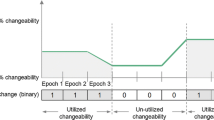Abstract
Today’s hypercompetitive worldwide market, demanding customers, and technological advances force corporations who develop new products to look into all the possible areas of improvement throughout the entire product life cycle management process. One of the research areas that have been overlooked in the past is engineering change management (ECM). This paper presents a simulation model for investigating the mutual impacts of ECM process and new product development (NPD) process on each other. The discrete event simulation model investigates how different NPD and ECM process characteristics are interrelated, and how these interactions eventually affect the lead time, cost, and quality of an NPD project. This model has the capacity to account for three different levels of uncertainties, namely activity uncertainty, design solution uncertainty, and environment uncertainty, and their effects on the probabilities of NPD rework. Decisions to be made by considering EC impacts are drawn from an enterprise level system perspective.
Similar content being viewed by others
References
Balakrishnan N, Chakravarty AK (1996) Managing engineering change: market opportunities and manufacturing costs. Prod Oper Manag 5(4):335–356
Barzizza R, Caridi M, Cigolini R (2001) Engineering change: a theoretical assessment and a case study. Prod Plan Control 12(7):717–726
Bhuiyan N, Gerwin D, Thomson V (2004) Simulation of the new product development process for performance improvement. Manag Sci 50(12):1690–1703
Bhuiyan N, Gregory G, Thomson V (2006) Engineering change request management in a new product development process. Eur J Innov Manag 9(1):5–19
Brown SL (1995) Product development: past research, present findings, and future directions. Acad Manag Rev 20(2):343–378
Browning TR, Eppinger SD (2002) Modeling impacts of process architecture on cost and schedule risk in product development. IEEE Trans Eng Manag 49(4):428–442
Browning TR, Fricke E, Negele H (2006) Key concepts in modeling product development process. Syst Eng 9(2):104–128
Browning TR, Ramasesh RV (2007) A survey of activity network-based process models for managing product development projects. J Prod Innovat Manag 16(2):160–172
Cho SH, Eppinger SD (2005) A simulation-based process model for managing complex design projects. IEEE Trans Eng Manag 52(3):316–328
Dragut AB, Bertrand JWM (2008) A representation model for the solving-time. Eur J Oper Res 189(3):1217–1233
Eckert C, Clarkson PJ, Zanker W (2004) Change and customisation in complex engineering domains. Res Eng Des 15(1):1–21
Ford DN, Sterman JD (1998) Dynamic modeling of product development processes. Syst Dyn Rev 14(1):31–68
Hillier FS, Lieberman GJ (2001) Simulation modeling & analysis, 4th edn. McGraw-Hill, New York
Ho CJ (1994) Evaluating the impact of frequent engineering changes on MRP system performance. Int J Prod Res 32(3):619–641
Huang GQ, Mak KL (1994) Current practices of engineering change management in HK manufacturing industries. Int J Oper Prod Manag 19(1):21–37
Krishnan V, Eppinger SD, Whitney DE (1997) A model-based framework to overlap product development activities. Manag Sci 43(4):437–451
Law AM (2007) Simulation modeling & analysis, 4th edn. McGraw-Hill, New York
Lévárdy V, Browning TR (2009) An adaptive process model to support product development project management. IEEE Trans Eng Manag 56(4):600–620
Loch CH, Terwiesch C (1999) Accelerating the process of engineering change orders: capacity and congestion effects. J Prod Innov Manag 16(2):145–159
Smith RP, Eppinger SD (1997) A predictive model of sequential iteration in engineering design. Manag Sci 43(8):1104–1120
Terwiesch C, Loch CH (1999) Managing the process of engineering change orders: the case of the climate control system in automobile development. J Prod Innov Manag 16(2):160–172
Wynn DC, Grebici K, Clarkson PJ (2011) Modelling the evolution of uncertainty levels during design. Int J Interact Des Manuf 5:187–202
Author information
Authors and Affiliations
Corresponding author
Appendices
Appendix A
Appendix B
Rights and permissions
About this article
Cite this article
Li, W., Moon, Y.B. Modeling and managing engineering changes in a complex product development process. Int J Adv Manuf Technol 63, 863–874 (2012). https://doi.org/10.1007/s00170-012-3974-x
Received:
Accepted:
Published:
Issue Date:
DOI: https://doi.org/10.1007/s00170-012-3974-x




